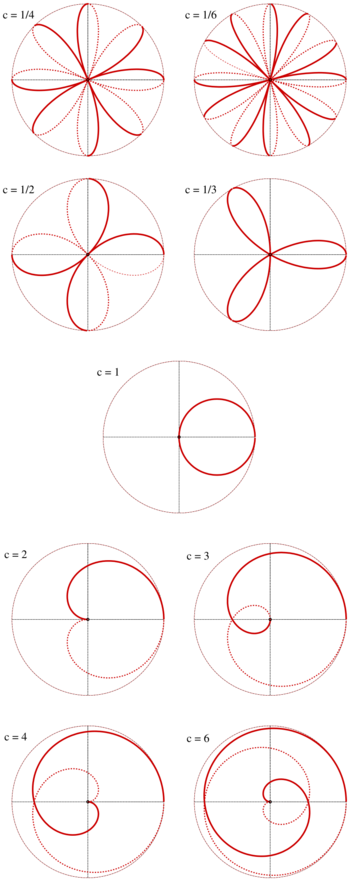Clélie

In mathematics, a Clélie or Clelia curve is a curve on a sphere with the property:[1]
- If the surface of a sphere is described as usual by the longitude (angle [math]\displaystyle{ \varphi }[/math]) and the colatitude (angle [math]\displaystyle{ \theta }[/math]) then
- [math]\displaystyle{ \varphi=c\;\theta, \quad c\gt 0 }[/math].
The curve was named by Luigi Guido Grandi after Clelia Borromeo.[2][3][4]
Viviani's curve and spherical spirals are special cases of Clelia curves. In practice Clelia curves occur as polar orbits of satellites with circular orbits, whose traces on the earth include the poles. If the orbit is a geosynchronous one, then [math]\displaystyle{ c=1 }[/math] and the trace is a Viviani's curve.
Parametric representation
If the sphere is parametrized by
- [math]\displaystyle{ \begin{align} x &= r \cdot \cos \theta \cdot \cos \varphi \\ y &= r \cdot \cos \theta \cdot \sin \varphi \\ z &= r \cdot \sin \theta \end{align} }[/math]
and the angles are linearly connected by [math]\displaystyle{ \; \varphi=c\theta }[/math], then one gets a parametric representation of a Clelia curve:
- [math]\displaystyle{ \begin{align} x &= r \cdot \cos \theta \cdot \cos c\theta \\ y &= r \cdot \cos \theta \cdot \sin c\theta \\ z &= r \cdot \sin \theta. \end{align} }[/math]
Examples
Any Clelia curve meets the poles at least once.
Spherical spirals: [math]\displaystyle{ \quad c \ge 2 \ , \quad -\pi/2\le \theta\le \pi/2 }[/math]
A spherical spiral usually starts at the south pole and ends at the north pole (or vice versa).
Viviani's curve: [math]\displaystyle{ \quad c=1\ , \quad 0 \le \theta\le 2\pi }[/math]
Trace of a polar orbit of a satellite: [math]\displaystyle{ \quad c\le 1\ ,\quad \theta\ge 0 }[/math]
In case of [math]\displaystyle{ \;c\le 1\; }[/math] the curve is periodic, if [math]\displaystyle{ c }[/math] is rational (see rose). For example: In case of [math]\displaystyle{ \; c=1/n\; }[/math] the period is [math]\displaystyle{ \;n\cdot 2\pi\; }[/math]. If [math]\displaystyle{ c }[/math] is a non rational number, the curve is not periodic.
The table (second diagram) shows the floor plans of Clelia curves. The lower four curves are spherical spirals. The upper four are polar orbits. In case of [math]\displaystyle{ \;c=1/3\; }[/math] the lower arcs are hidden exactly by the upper arcs. The picture in the middle (circle) shows the floor plan of a Viviani's curve. The typical 8-shaped appearance can only achieved by the projection along the x-axis.
References
- ↑ Gray, Mary (1997), Modern Differential Geometry of Curves and Surfaces with Mathematica (2nd ed.), CRC Press, p. 928, ISBN 9780849371646, https://books.google.com/books?id=-LRumtTimYgC&pg=PA928.
- ↑ Chasles, Michel (1837) (in French), Aperçu historique sur l'origine et le développement des méthodes en géométrie: particulièrement de celles qui se rapportent à la géométrie moderne, suivi d'un Mémoire de géométrie sur deux principes généraux de la science, la dualité et l'homographie, M. Hayez, p. 236, https://books.google.com/books?id=XBkzAQAAMAAJ&pg=PA236.
- ↑ Montucla, Jean Etienne; Le Français de Lalande, Joseph Jérôme (1802) (in French), Histoire Des Mathématiques: Dans laquelle on rend compte de leurs progrès depuis leur origine jusqu'à nos jours : où l'on expose le tableau et le développement des principales découvertes dans toutes les parties des Mathématiques, les contestations qui se sont élevées entre les Mathématiciens, et les principaux traits de la vie des plus célèbres, Agasse, p. 8, https://books.google.com/books?id=2dJGAAAAcAAJ&pg=PA8
- ↑ McTutor Archive
- H. A. Pierer: Universal-Lexikon der Gegenwart und Vergangenheit oder neuestes encyclopädisches Wörterbuch der Wissenschaften, Künste und Gewerbe. Verlag H. A. Pierer, 1844, p. 82.
External links
- Clelia., Mathcurve.com..


